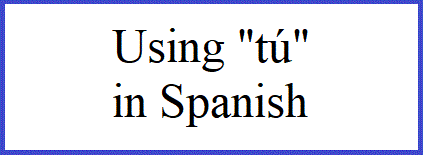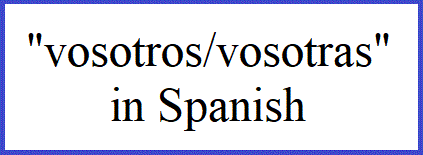The Spanish language has four words for you (Tú, Usted, Vosotros, Vosotras and Ustedes). They can be confusing, particularly to beginners, but are very logical. This article explains the differences and what endings to use in the present tense.

As mentioned above, there are four ways of saying ‘you’ in Spanish (namely tú, usted, vosotros and ustedes). The one you use used depends on:
• whether you are talking to one person or more than one person
• whether you are talking to someone formally (e.g. to a complete stranger) or informally (e.g. to a friend/(young) child)
The verb ending also varies, depending on whether:
• your verb ends in ar (e.g. hablar = to talk), er (e.g. comer = to eat) or ir (e.g. vivir = to live) in its dictionary form (known as the infinitive).
This page focuses on traditional usage of the different versions of ‘you’ in Spain, but please be aware there are variations, particularly in South America.

The ‘tú‘ form for ‘you’
The tú form for ‘you’ is usually used when you are speaking to one person informally. The main situations where you use tú are:
• speaking to one friend (or to one person like a friend); or
• speaking to one (young) child
The verb ending for the ‘tú‘ form in the present tense usually ends in as for ‘ar’ verbs or ‘es‘ for ‘ir’ and ‘er’ ending verbs. Therefore:
- hablar (to talk) becomes hablas (you talk) (informal and singular ‘you’)
- comer (to eat) becomes comes (you eat) (informal and singular ‘you’)
- vivir (to live) becomes vives (you live) (informal and singular ‘you’)

The ‘usted’ form of ‘you’
The usted form of ‘you’ is usually used when you are speaking to one person formally. The main situations where you use usted are:
- speaking to a complete stranger; or
- speaking to one person in authority.
The verb ending for the ‘usted’ form in the present tense usually ends in a (for ‘ar’ verbs) and e (for ‘er’ and ‘ir’ verbs). Therefore:
- hablar (to talk) becomes habla (you talk) (formal and singular ‘you’)
- comer (to eat) becomes come (you eat) (formal and singular ‘you’)
- vivir (to live) becomes vive (you live) (formal and singular ‘you’)

The ‘vosotros/vosotras’ form of ‘you’
The vosotros/vosotras form of ‘you’ is usually used when you are speaking to more than one person informally. The main situtations where you use vosotros/vosotras* are:
- speaking to two or more friends (or to two or more people like friends); or
- speaking to two or more (young) children
The verb ending for the ‘vosotros/vosotras’* form is usually áis (for ‘ar’ verbs), éis (for ‘er’) and ís (for ‘ir’ verbs). Therefore:
- hablar (to talk) becomes habláis (you talk) (informal and plural ‘you’)
- comer (to eat) becomes coméis (you eat) (informal and plural ‘you’)
- vivir (to live) becomes vivís (you live) (informal and plural ‘you’)
*’Vosotros’ is the informal plural ‘you’ when you are speaking to all males or a mix of males and females. ‘Vosotras’ is the informal plural ‘you’ when you are speaking only to females. The verb ending is identical for both ‘Vosotros’ and ‘Vosotras’ (i.e. áis (for ‘ar’ verbs’), ís (for ‘ir’ verbs) and éis (for ‘er’ verbs).

The ‘ustedes’ form of ‘you’
The ‘ustedes’ form of ‘you’ is usually used for speaking to more than one person formally. The main situations where you use ustedes is:
- Where you speak to two or more strangers; or
- Where you speak to two or more people in authority.
The verb ending for ustedes is usually an (for ‘ar’ verbs) and en (for ‘er’ and ‘ir’ verbs. Therefore:
- hablar (to talk) becomes hablan (you talk) (formal and plural ‘you’)
- comer (to eat) becomes comen (you eat) (formal and plural ‘you’)
- vivir (to live) becomes viven (you live) (formal and plural ‘you’)
Give your Spanish a boost by taking Online Spanish Tuition!
Hopefully this has helped you to understand which form of ‘you’ is used in European Spanish. You could improve your confidence using the Spanish language by taking online Spanish lessons (typically £23 for 60 minutes for one person). See more information on Spanish Language Tuition offered here.